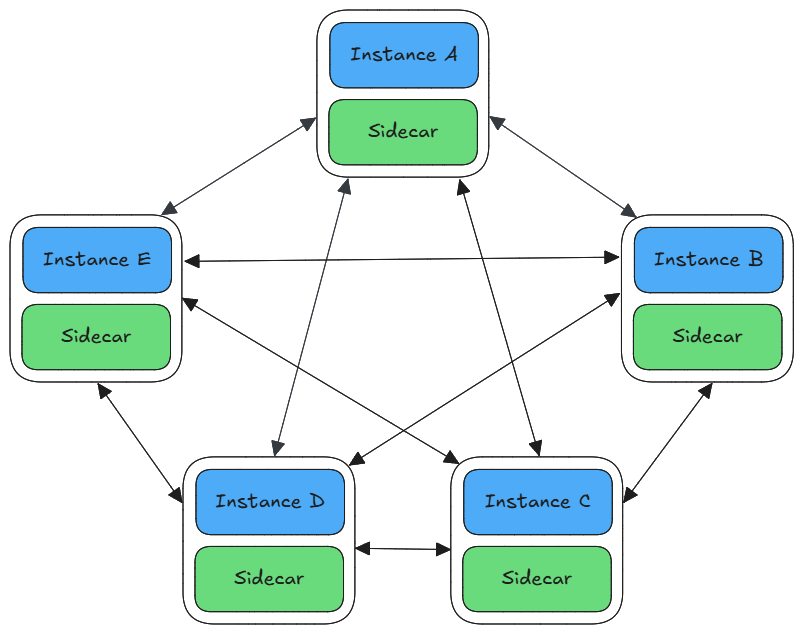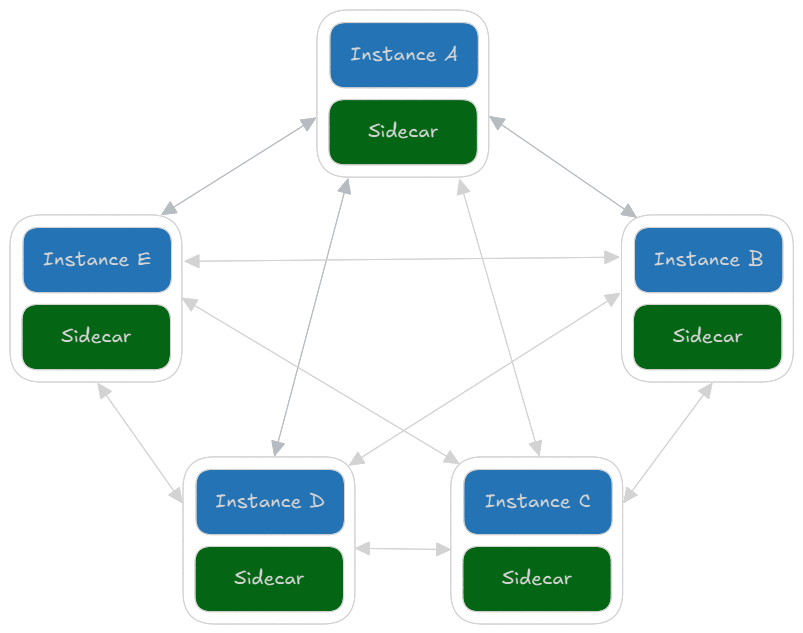How Service Mesh Supercharges Deployments on Viduli - Part 1: Load Balancing & Service Discovery
Modern microservices need more than just deployment—they require intelligent networking and security. A service mesh automates traffic routing, security, and service discovery, making deployments on Viduli more scalable and resilient. This article explores how service mesh enhances load balancing and simplifies service discovery, helping developers build efficient, high-performance cloud applications.
 Avin Kavish
Avin KavishFebruary 18, 2025
Architecture,Microservices,

What is a Service Mesh?
A service mesh is a dedicated layer of infrastructure that manages service-to-service communication in a distributed system. As applications grow in complexity — especially when using microservices architectures — services need a reliable way to communicate, remain secure, and scale efficiently.
The Challenge with Microservices Communication
In a traditional monolithic application, all components communicate internally, making it easy to handle things like load balancing, security, and monitoring. However, in a microservices-based architecture, services are deployed independently, often running across different containers, VMs, or cloud environments. This introduces several challenges:
Service Discovery — How do services know where to find each other?
Traffic Management — How do you ensure requests reach the right service, even during failures?
Security — How do you enforce authentication and encryption between services?
Observability — How do you monitor requests across multiple microservices?
Resilience — How do you handle failures and ensure high availability?
A service mesh solves these challenges by providing an automated, programmable infrastructure layer that manages these concerns outside of the application code.
How a Service Mesh Works
A service mesh consists of two main components:
Data Plane — This is responsible for handling actual service-to-service communication. It consists of lightweight proxies (often sidecars like Envoy) that sit next to each microservice, intercepting all traffic.
Control Plane — This manages the proxies and provides a centralized way to configure networking, security, and observability policies.
When a request is made between services, the data plane proxies ensure that it is securely routed, load balanced, and logged. Meanwhile, the control plane allows developers to set rules for how services interact (e.g., traffic routing, authentication policies, retries, and monitoring).
Popular Service Mesh Technologies
There are several open-source and enterprise-grade service meshes available today, including:
Istio — One of the most popular, used with Kubernetes.
Linkerd — Lightweight, simpler alternative to Istio.
Consul — Provides service discovery, security, and networking across any environment.
a. Traffic Management & Load Balancing
Problem: How do microservices efficiently route and manage traffic?
In a distributed system, services often need to communicate across multiple instances, regions, or cloud environments. Without proper traffic management, requests can be randomly distributed, leading to bottlenecks, failures, or inefficient resource use.
Traditional Load Balancer vs. Service Mesh Load Balancing
The conventional method of load balancing relies on a centralized load balancer (e.g., Nginx, HAProxy, AWS ELB) that sits at the entry point of an application and distributes incoming traffic across multiple backend instances. While effective, this approach has limitations:


The conventional approach to load balancing relies on a centralized load balancer (such as Nginx, HAProxy, or AWS ELB) that sits at the entry point of an application and distributes incoming traffic across backend instances. While effective, this approach has several limitations compared to a service mesh-based load balancing system.
How Service Mesh Improves Load Balancing on Viduli
Intelligent Load Balancing: Instead of a single, external load balancer, service mesh distributes traffic at every service level, optimizing latency, health, and efficiency dynamically.
Resilience & High Availability: If a service instance fails, traffic is automatically redirected to healthy instances without depending on a centralized load balancer.
Dynamic Traffic Splitting (Canary & Blue-Green Deployments): Developers can gradually route a percentage of traffic to a new service version for testing before a full rollout.
Better Performance in Large-Scale Systems: Instead of funneling all requests through one central point, traffic is distributed more efficiently within the system, reducing bottlenecks.
Aspect | Traditional Load Balancer | Service Mesh Load Balancing |
|---|---|---|
Traffic Routing | Routes requests only at the entry point of the system. | Routes traffic dynamically at each service level, optimizing communication. |
Single Point of Failure | If the load balancer fails, the whole system can be affected. | Decentralized, as each service proxy handles its own load balancing. |
Scaling | Requires manual scaling and additional infrastructure. | Automatically adapts to service instances scaling up/down. |
Granular Control | Limited to basic load balancing rules (round-robin, least connections). | Provides advanced traffic routing, such as latency-based or weighted routing. |
Internal Service Communication | Does not handle inter-service traffic, requiring additional internal routing solutions. | Optimizes both external and internal service communication |
Example Use Case:
A multi-region application running on Viduli needs to route traffic between instances in Asia, Europe, and North America. Instead of sending all requests through a single load balancer (which may become a bottleneck), Viduli’s service mesh load balancing ensures that:
✅ Global requests are intelligently routed to the nearest, least-loaded instance.
✅ Internal microservices communicate efficiently without unnecessary hops.
✅ Failover happens automatically, with minimal latency disruptions.
By using service mesh-based load balancing instead of relying on a centralized entry-point load balancer, Viduli users get better scalability, resilience, and flexibility — without additional infrastructure overhead.
b. Simplified Service Discovery & Networking
Problem: How do services dynamically discover and communicate with each other?
In a monolithic application, all components are tightly integrated, so communication between them is straightforward. However, in a microservices architecture, services are deployed independently, often across multiple servers, containers, or cloud regions. This introduces several networking challenges:
Service Discovery Issues
How do microservices locate each other when instances scale dynamically?
Manually assigning IP addresses or DNS records is inefficient and impractical in a cloud-native environment.
Networking Complexity
Traditional networking requires manual configurations, firewalls, and DNS management to ensure services communicate correctly.
As microservices scale, developers must manage service-to-service connectivity, security policies, and network topologies — adding significant operational overhead.
Multi-Cluster & Multi-Region Communication
In global applications, services might be deployed across multiple clusters or cloud regions.
Ensuring low-latency, secure, and efficient communication between these services is a major challenge.
How Service Mesh Solves These Challenges
1. Automatic Service Discovery
A service mesh eliminates the need for manual service discovery by dynamically registering and managing service instances. Instead of relying on hardcoded IP addresses or static DNS records, services communicate using logical names, and the service mesh automatically resolves their locations.


💡 Example:
Instead of configuring
orders-service.example.commanually, a service can simply callorders-service, and the service mesh will route the request to the correct, healthy instance automatically.If an instance of a service scales up or down, the service mesh automatically updates its routing table — ensuring seamless traffic flow.
2. Simplified Networking & Traffic Routing
With a traditional networking model, developers must configure:
Ingress/Egress policies
DNS records for each service
Firewall and access control rules
Custom scripts for load balancing
A service mesh abstracts all of this. It creates a virtual service-to-service network where microservices can communicate securely and efficiently without developers needing to configure complex networking rules.
💡 Example:
If a payments service needs to call an orders service, it does so without worrying about network configurations. The service mesh automatically discovers, secures, and routes traffic without developer intervention.
3. Multi-Cluster & Multi-Region Support
A service mesh ensures seamless communication between services, regardless of their location — whether they are running in different Kubernetes clusters, cloud providers, or data centers.
💡 Example:
A global e-commerce platform using Viduli might have services in North America, Europe, and Asia.
Instead of manually configuring networking between these regions, the service mesh automatically routes traffic to the nearest or most available instance.
This reduces latency for users and optimizes traffic flow, improving the overall performance of the application.
Why This Matters for Viduli Users
Viduli is designed to simplify cloud infrastructure, and service mesh removes the burden of manual networking management. Developers can:
✅ Deploy services without worrying about networking configurations — The service mesh automatically handles communication.
✅ Achieve high availability across multiple regions — Traffic is routed dynamically to the best-performing instance.
✅ Eliminate downtime due to service changes — New service instances are discovered automatically.
✅ Scale applications seamlessly — As services grow or shrink, the mesh keeps traffic flowing correctly.
By using Viduli’s built-in service mesh, developers can focus on building applications instead of managing networking complexity, service discovery, and routing policies. 🚀
Get Started with Viduli Today
Ready to deploy your scalable, secure, and high-performance applications with built-in service mesh capabilities?
👉 Sign up for Viduli today and experience seamless microservices deployment!
What’s Next?
In this article, we focused on how service mesh enhances load balancing and simplifies service discovery — critical components for modern cloud applications. But there’s more!
In the next article, we’ll explore how service mesh improves observability and fault tolerance on Viduli. You’ll learn how to:
🔹 Monitor real-time traffic and performance with built-in tracing and metrics.
🔹 Implement circuit breakers and automated failover to prevent cascading failures.
🔹 Debug microservices easily with distributed tracing.
Stay tuned! 🚀



